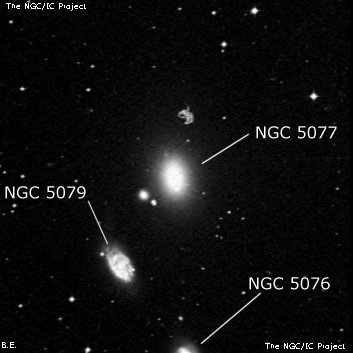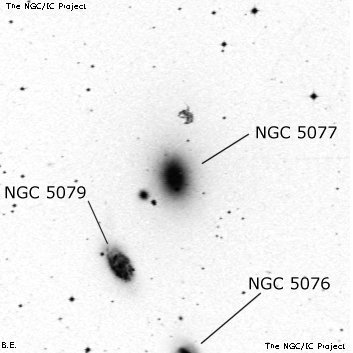NGC/IC Project Restoration Effort
(This is a very very beta version)
NGC5077


Basic Information
Location and Magnitude
Right Ascension: 13:19:31.6
Declination: -12:39:24
Constellation: VIR
Visual Magnitude: 11.4
Historic Information
Discoverer: Herschel W.
Year of discovery: 1784
Discovery aperture: 18.7
Observational
Summary description: pB, S, vlE, sbM, 2nd of 3
Sub-type: E3
Corwin's Notes
=====
NGC 5077 area. The Herschels observed the triplet, N5076-77-79 whose
identities are not in doubt. Lord Rosse found N5072 and N5088, as did
d'Arrest. There is some confusion in their observations concerning stars near
N5072: both Howe and Swift comment that the object at first looks like a
double star, with the nebula about 15 arcsec nf the star. But there is also
another star about 1.7 arcmin nf the nebula; this was seen by Howe and
Bigourdan (who, oddly, did not mention the star sp). It is possible that Lord
Rosse's observers saw both, but on different nights, and that d'Arrest missed
the sp star, just as Bigourdan did. Swift notes 6 nebulae in the area. He
probably also saw the one labeled RNGC 5070 (it's possible that he saw the
otherwise unnoticed object np N5088; this is brighter than RN5070), but it is
clear that his description is for N5072. So, the obvious conclusion for these
two is that N5072 = N5070 (not = RN5070) which is the galaxy 15 arcsec
north-following the star seen by Howe and Swift. There is a bit more
discussion under NGC 5070.
Steve's Notes
=====
NGC 5077
17.5" (6/11/88): second of three and brightest in a group with NGC 5079 3.0' SSE and NGC 5076 5.0' S. Fairly bright, fairly small, oval ~N-S, bright core, stellar nucleus. A mag 14 star is 0.9' SE and an extremely faint mag 15 "star" is at the southeast end. The mag 15 "star" mentioned above is actually a very faint companion in contact.



